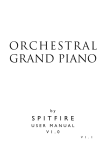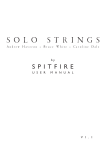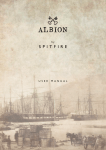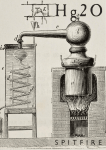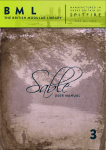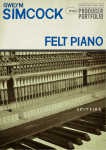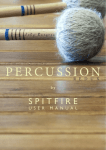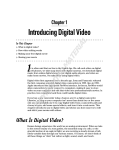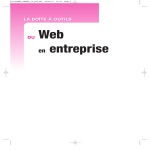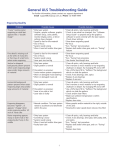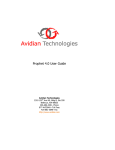Download CIMBALOM - Amazon Web Services
Transcript
CIMBALOM by S P I T F I R E USER MANUAL V1.0 Welcome. Thanks for purchasing the Spitfire Grand Cimbalom, an essential addition to your orchestral palette made “the Spitfire way”. Reading manuals is a bore, so stick this next to your loo and give a read whenever you can, you may find a host of good tips and ideas on how to get the best out of your purchase. About Spitfire: Spitfire was formed in 2008 by a group of successful British composers as a means of producing the tools they needed for their busy work schedules. Sick of dry, humourless, ugly, unrealistic, enormously untamable sounding libraries, Spitfire set about redefining the way samples were created. Our aim is to reproduce the conditions of top movie recording sessions and approach sampling as if we were recording a film score one note at a time. To record performances, and parts thereof, not scientifically created samples. To capture the timbre of a world-class set of players but also to record the room they were playing in. About This Module: Spitfire Grand Cimbalom is part of what we would refer to as the “Definitive” range within Spitfire commercial products. Whereby we aim to provide a single stop solution, a definitive version of an instrument or group of instruments. It is our intention that these modules are the best in their field and are sampled in a way to future proof advances in technology and provide our users with tools that make the sonic character easily adjustable for a number of applications. The Spitfire Cimbalom is presented to you by virtuoso Greg Knowles who’se beautiful instrument (the sound board of which is used in our artwork) and fervent enthusiasm and passion, we hope, has been captured here for your enjoyment. Greg kindly took us through the technicalities of the instrument and has advised us how best to approach it’s complexities. Combined with Jake Jackson’s masterful handling of this instrument in the world famous Lyndhurst Hall, Air - Studios and a set of easily controllable microphone positions, we believe this to be a totally unique addition to your sonic arsenal. But wait ‘til you hear it! The cimbalom is a concert hammered dulcimer: a type of chordophone composed of a large, trapezoidal box with metal strings stretched across its top. It is a musical instrument popularized in Hungary and commonly found throughout central and eastern Europe. The cimbalom is played by striking two beaters against the strings. The steel treble strings are arranged in groups of 4 and are tuned in unison. The bass strings which are over-spun with copper, are arranged in groups of 3 and are also tuned in unison. The cimbalom has been used in many film scores over the years famously John Barry used it in the title theme for the film The Ipcress File, as well as in the main theme of the 1971 TV series The Persuaders!. But it’s most famous, and coolest use was probably on the 1994 Portishead track “Sour Times”. An example of how the instrument can be used as a mournful exotic sound not just it’s often stereotypical use against East European backdrops, spy intrigue and cold war thrillers. Aside from being an amazing featured or solo instrument. It is also great as a textural element; doubling pianos and other tuned percussion instruments, it’s particularly interesting in unison with pizzicato passages. A fantastic new colour for your palette and with this level of deep sampling, something that can sit proud and exposed in your mixes and honestly and realistically express the emotion of your composition. Greg’s Cimbalom was recorded in the hall at Air Studios, London, one of the greatest recording studios in the world. Sampled with 4 round robins and 2 dynamics as single hits, and of course the characteristic tremolando. (Its not a massively dynamic instrument but we have smoothly enabled you to make it as dynamic or not as you wish, via front panel velocity map.) Options exist to use ‘Piano’ sustain pedal style, or the reverse authentic ‘Cimbalom’ style (where pedal up is the ringing out sustained sound). Recorded through the finest mics via exclusive Neve “Montserrat” Pre-Amps and Prism AD converters. The Spitfire Cimbalom joins our Harpsichord and Harp as the definitive VI in its class. The Cimbalom is presented with 4 mic positions (Close, Tree, Ambient, Outriggers). System Requirements KONTAKT Spitfire Cimbalom is NOT a Kontakt Player library, so you WILL need a full version Kontakt to run it. PLEASE MAKE SURE YOU HAVE THE LATEST VERSION OF EITHER KONTAKT 4.2.4 OR 5 INSTALLED. Because this module doesn’t authorise through the NI Service Centre and is personally watermarked, you will be able to install on all the machines you own. Owning a full version of Kontakt will afford you the luxury of being able to edit and revise the patches to your particular preference. Remember we pride ourselves in making truly esoteric tools, so if there’s a sample you don’t like, you can change it for another with relative ease. RECOMMENDED SPEC: The better your computer, the better the performance of any Spitfire module. But not to worry if you’re not spec’d up to the hilt. All programs are provided with a set of parameters that enable you to tone back the CPU demands of any given patch. But moving forward, we’re confident this module will keep your computer busy for many years to come! We recommend a combination of high processor speeds, a good chunk of memory and a devoted 7200rpm eSata, USBII, Thunderbolt, or Firewire audio drive. The more memory you have, the less demand placed on your drive, and having a totally devoted drive gives you the chance to load less into memory and reduce load times. The higher the speed of your CPU, the more capable your computer will be to deal with some of the amazing, but complicated scripts we’ve written. PCs: We recommend an i5, or i7 Quad or 8 Core machine with 8 Gig or above memory. Vista 64 or WIndows 7. However, it will work with SP2, Pentium or Athlon XP 1.4GHz 1Gig RAM. MACs: We recommend a Mac-Pro Intel Based Dual, Quad or 8 Core machine with 8 Gig or above memory. Mac OS 10.6.1 (Snow Leopard). However, we have made the module work satisfactorily on a Mac Mini 2.4 GHz and a MacBook Pro 2.4GHz Intel Core 2 Duo. DRIVES: Firewire, USBII, or eSata, 7200rpm. Ask your dealer for drives that are suitable for “AV use”. We always recommend as small a drive as possible, as the platter will be smaller and the seek time less. The library will eventually take up 5-6 Gig on your hard drive. If using several large libraries, or a number of Spitfire modules from the same machine, we really recommend having your samples distributed over a number of drives. Lacie eSata or Quadras 7200rpm we highly recommend. Moreover, an exciting development lies in the recent arrival of some amazing solid state (SSD) drives. With seek times reduced to a fraction (0.1ms vs 6-9ms) of what standard drives can offer, we are certain you will be able to reduce your sampler’s “pre-load” (page 15.) buffer tenfold meaning you’ll be able to load enormous orchestral palettes into a single machine. HOST: The Kontakt 4 platform should work comfortably on most commonly found platforms and DAWs. As always make sure you’re as up-to-date as you can afford! If you’re planning on building or adding Spitfire to an already large orchestral palette, we recommend running your library independently of your DAW, either on your host computer (e.g. via Re-Wire) or on a slave device (e.g.. via Midi or MOL). This will assist your loading times, and will allow your DAW to do what it does best, sort out all your note ons and note offs! We heartily endorse Plogue Bidule (www.plogue.com) as a virtual rack/ routing system. For more advice and information about setting up please check our website. CONTENTS: INSTALLATION05 GETTING STARTED05 THE FRONT PANEL06 SURROUND USE08 AFAQs10 INSTALLATION Because you’re reading this manual, we can presume you have successfully downloaded The Spitfire Grand Cimbalom. Included in your download email are some detailed installation instructions, please follow these carefully before going any further. We’ll see you back here, when you’re installed! GETTING STARTED Before opening Kontakt please make sure you have THE LATEST VERSION OF KONTAKT 4.2.4 OR 5 INSTALLED. 95% of all service enquiries relating to spurious or strange behaviour of our wares are solved by installing the most recent version. As this is NOT a Kontakt Player Library YOU WILL NOT SEE THE MODULE IN THE LIBRARY PANE. Simply navigate to the CIMBALOM via the “File” browser pane. If you have never used Kontakt before we wholeheartedly recommend your familiarise yourself with the basics of patch (or instrument) loading, multi management, outputting and MIDI routing detailed in the Kontakt user-manual provided with your copy of Kontakt or in the “documentation” folder of your Kontakt file. 5. THE FRONT PANEL 2. 1. 8. 11. 9. 3. 12. 4. 10. 5. 6. 7. 6. THE FRONT PANEL KEY: This manual presumes that you have already used Kontakt. If the main Kontakt window is unfamiliar to you please consult your Kontakt manual or the Native Instruments site. They explain it better than we ever could: http://www.native-instruments.com/#/en/products/producer/kontakt-5/ 1. Voices & Max. The left numeral refers to how many voices are currently being processed in the Kontakt engine. Max. Refers to the maximum number of voices assigned to this instance of Kontakt. If you’re experiencing dropouts, clicks or crackles you may want to have a look at these two numbers. If the “voices” numeral creeps up and equals the “max” numeral you may want to increase your voice ceiling (the max setting). 2. Samples Load Status. Again, if you’re hearing clicks or crackles or if your sample is cutting out erratically check that the rightmost bar is illuminated. This signals that all the samples for your patch are fully loaded. If the lefter-most panel is illuminated the patch has yet to start loading, the middle, the patch is in the process of doing so. 3. Mic Controllers One of the most exciting aspects of the Spitfire range. C(lose) T(ree) A(mbient) & O(utboard) mics. Above these letters are the mic cut buttons that dial the mic signals in or out, this will unload or load the samples needed to keep your system lean. Above the cut buttons are fader controls that allow you to mix the mic signals to your liking. If you drag these faders to 0 this will also unload the associated samples. C - Close mics, two matched valve mics placed for optimum focus close to the instrument. This mic control is great to add in for added definition and at times a bit of “rounding of sound”, in isolation it can be a way of achieving a more intimate or pop-music style sound. T - Tree. This refers to the “Decca” tree of three mics placed above the conductor’s podium. In the case of Albion; 3 priceless vintage Neumann M50s. These are placed to give the ultimate sound of the band, the hall and are the default mic position that loads in with each patch. A - Ambient. A set of condenser mics set wide apart on either side of the same lateral plane as the Tree. O - Outriggers. A set of condenser mics placed high up in the gallery away from the band. This mic position gives a massive amount of stereo spread and room sound over the band. Great mixed in with the other mics but also ideal fed to your Ls & Rs speaker sends for true surround information (see page 23). As a new feature to our MM (Multi Mic) VI’s we are now mapping the mic controllers to C=CC22, T=CC23, A=CC24, O=CC25. This is a feature requested by users with larger rigs/ palettes which enables mix tweaking/ unloading/ loading of samples (value = 0) via a controller without having to go into the UI. 4. Purge Unused unloads unused samples from memory to keep your memory usage as low as possible. 5. Transpose is a convenient way of transposing the instrument. This does not work the same way as course tune which actually tunes all samples up and down, it simply address different samples as per the number you select. An excellent trick is to transpose the instrument by -3 then course tune up by 3 semitones. Run this in unison with an original instance of the instrument reverse L&Rs on this new transposed instance and pan a little to the left and right and hey presto duelling Cimbaloms, even when in tight unison these will still sound like two instruments. 7. 6. Tremolando Level. This lever controls tremolando and is mapped to CC1 (Mod Wheel). 7. Expression (#CC11) This lever displays expression level and also controls it if you wish. 8. Round Robins. This sets the number of Round Robins (different samples for the same note to avoid the tell tale “machine gun” sample giveaway) you wish to use. 9. Reset from C1. This resets the Round Robin cycle from note C1. This enables you to precisely control the round robin cycle so that it sounds identical on every playback. 9. Reset On Transport. Toggle this on to reset the Round Robin cycle every time you hit play on your DAW. 9. Neighbouring Zones. -- ****We have removed this feature from the release version of the library as the Cimbalom is particularly sensitive to re-tuning and stretching zones - and doing this sounds bad..**** 9. Custom Velocity Curve. Alter this to make the instrument react to the dynamic idiosyncrasies of your playing style and keyboard. 8. SURROUND USE: If you are lucky enough to work in 5.1 you will be delighted by how the piano works in this respect and with the number of mic combinations, there’s a number of different ways of doing it. The basic principal is to load in several instances of the same patch routed to the same MIDI channel with different mics selected and each instance routed to a different out, or panning selection on your surround panner. Each, and all microphone samples have been edited to sample accuracy together, so provided you give each instance identical MIDI information, or indeed the same channel, everything will remain true as recorded. If you are concerned that a round robin cycle may be out of sync, hit C0 on your keyboard controller to reset. Here’s some suggestions: Basic Quad (2 instances): Output an instance with T(ree) to your L&R, A(mbient) to your Ls & Rs. Intermediate 5.0 (3 instances) Output an instance with T(ree) to your L&R, A(mbient) to your Ls & Rs. Bus a slightly smaller amount of Tree into your C alongside a final instance with C(lose). Posh 5.1 (4 instances + some clever routing): It would be easy for us to suggest you simply pull up the LFE fader as found in Logic (pictured above) on one of your 4 instances. Indeed, the C(lose) mic would be a nice focussed signal for this task. But your dubbing engineer wont like your for it, and 9 times out of 10, he’ll simply cut all of your LFE tracks. You can make his life easier by understanding the much misunderstood roll of the LFE track in cinemas. This is, as the title suggests, an “effects” track. It is for intermittent use (albeit these-days, often used!). This should never be part of your bass management and should be used in a selective manner. If you give them continuous program, they’ll strip it out as it will interfere with their room tones, nice bangs and thuds. And with a 60 piece orchestra all sorts of info gets into the sub range if you simply route your mix to it, even with instruments playing in a pitch range well clear of the sub. Your C(lose) signal is a good starting point. Route this to a sub bass synthesizer, the Waves MaxxBass is a great plug, alongside many free plugs bundled with DAWs. But the DBX 120A is very much the industry standard, and inexpensive bit of outboard kit for this purpose. Send your C(lose) into this but also make sure you noise gate it. Judge a point that you feel is a loud peak, and set the threshold to that, with a nice slow attack and release. Hey presto, you just made friends with a dubbing engineer. 9. AFAQs (Anticipated FAQs) Our first comment is to remind everyone that this is a manual to accompany v1.0 of a totally new line for Spitfire. With a totally new set of samples, scripts, and UI. We have used our experience as busy film composers to deliver something that we’d like. It is our hope that you keep in touch with us to let us know how you’re getting on, how you’re using the Harpsichord, how you’re finding it, and, if we were to consider looking at areas in the future, what you’d like us to look at. From this we’ll form a consensus and wholeheartedly pledge that we will act upon it wherever possible or practical. See you at v10.0! • This library really isn’t behaving how I’d expect. - OK, so we’re now officially blue in the face. But before you go ANY further please check you are using the ABSOLUTE latest version of Kontakt. Visit your trusty service centre and we hope this page remains relatively under-thumbed. • My instrument or patch seems to be playing just bits of sound, some keys are missing, and there’s lots of clicks and crackles. - Make sure that your patch is fully loaded (detailed on the front panel, page 9). Some of these are biggies so can take a while. But if problems persist make sure Kontakt memory manager is activated: then: You’ll have to restart this instance of Kontakt to feel it’s benefits. Another reason your system may be struggling is that you’re using too many mics live for the spec of your machine. Try cutting the mics as detailed on the front panel to see if this cures your problem. If it does, don’t worry you can still use these mics, just play in your parts with one active (we recommend the T(ree)) and then activate multiple mics and render down (eg. freeze function in Logic Studio). If you’re still suffering may we suggest you try and manage your pre-load buffer. Kontakt pre-loads some samples into memory so that when you hit a note Kontakt plays it out from RAM whilst addressing the rest of your samples from your hard drive(s). The slower your drives, the more you may want to rely on RAM, the faster the drives, or smaller RAM available, the more you may want to rely or your drives. If you’re using the latest generation of SSDs you’ll find you can radically reduce your pre-load buffer. Referring to the plate above tick the “Instruments Default Pre-Load Buffer Size” and drag the fader to a setting you’re happy with. 10. • I’m a media composer, and my cues take an age to load between cues. - Ha ha, we too wish that some DAWs handled memory a bit better. Make sure the Kontakt Memory Manager is on (detailed above), and try and create a palette from which all your cues derive. But most importantly, if you’re using a lot of our sounds. Try and run your orchestral palette in the background, either via rewire using Plogue Bidule for example, or indeed from an entirely different “slave” computer. • You keep mentioning “round robins”, what are they? - * Round Robins are a method of recording a number of versions of the same sample so that when playing repeated notes in fast succession you don’t get “machine gunning” a rapid repeat of the same sample that gives the game away immediately. • You keep mentioning “release trigger samples”, what are they? - These are individual samples of the sound of the release trail the minute the piano keys are lifted and give you the true character of the hall. They are designed to trigger when you lift your key and the level of these can be controlled with the slider provided. 11. A QUICK THANKS Christian & Paul would like to thank Dominic Kelly, Alison Burton and the whole of the Air Studios team. To Jake Jackson for making everything sound so marvellous, and the remarkable talents, immense intellect and invention of James Bellamy, Stanley Gabriel, Andrew Blaney, Blake Robinson and Stu Kennedy. Most of all we would like to thank the amazing support and loyalty of our user-base, our Facebook friends and everyone at VI Control. We are in the same boat as all of you. We’re not software developers by trade, so appreciate your honesty in paying your way to be a part of our family and not distributing this illegally. But more importantly, if you have any ideas or criticism please let us know directly via our website and in a constructive manner. You never know, you just may have thought of something that we hadn’t considered. We want to make our entire range the best there is, and we rely on you to help us achieve that..... With thanks. Christian & Paul. COPYRIGHT SPITFIRE AUDIO LLP 2012 www.spitfireaudio.com













